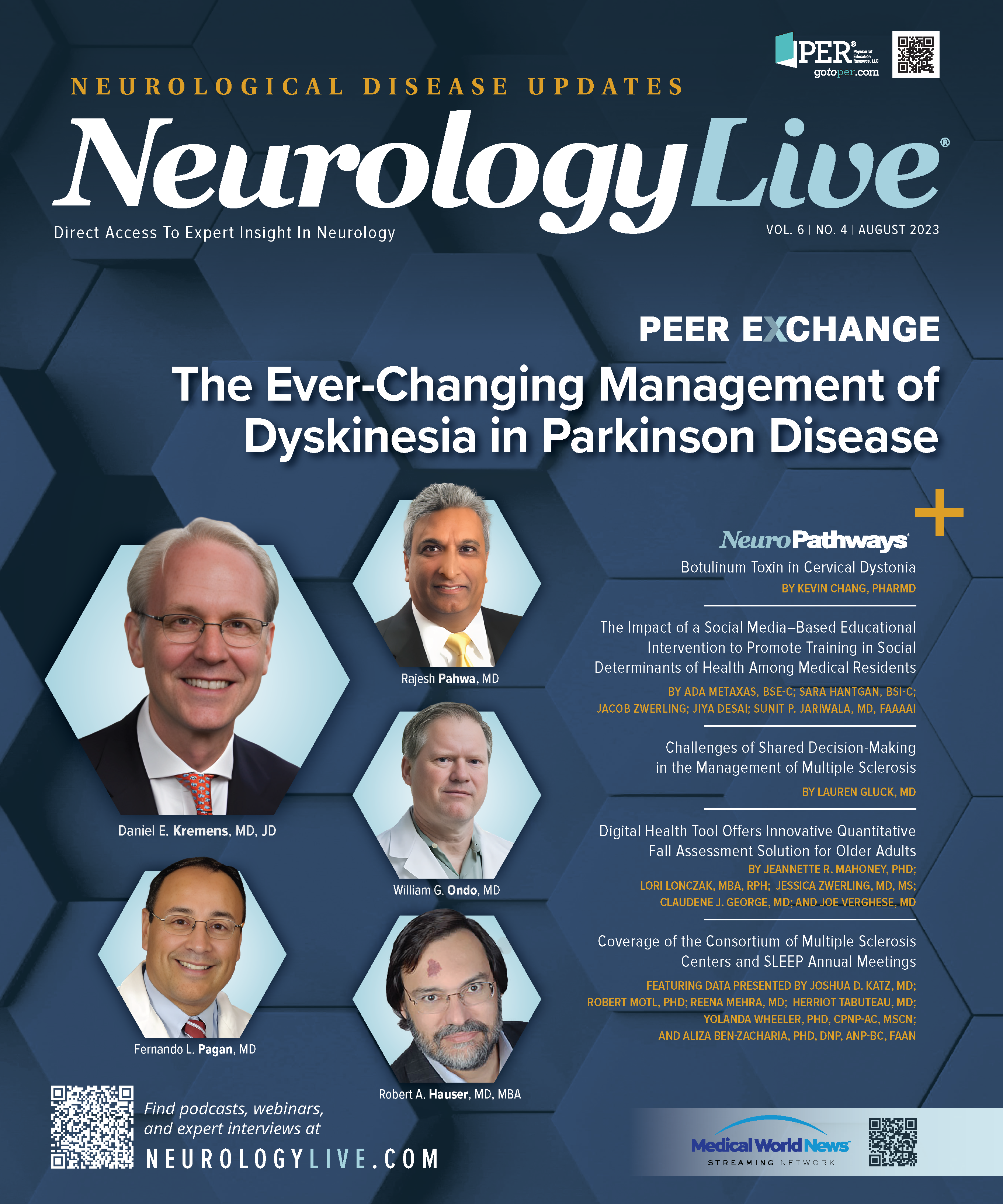Publication
Article
NeurologyLive
Challenges of Shared Decision-Making in the Management of Multiple Sclerosis
Author(s):
Although challenging, shared decision-making is a rewarding part of the practice of medicine. Involving patients in therapeutic decisions can improve patient autonomy and satisfaction—but it is not easy to implement.
Prefer to listen to your news? Click play to hear this article read aloud by AI. [LISTEN TIME: 9 mins]
Lauren Gluck, MD

SHARED DECISION-MAKING (SDM) is a challenging, yet rewarding, aspect of the practice of medicine, particularly in the field of multiple sclerosis (MS). Here, there are 23 FDA-approved disease-modifying therapies (DMTs) to help control a complex neurologic disease not well understood by most patients. Involving the patient in therapeutic decisions can enhance patient autonomy and satisfaction with their care plan. But it is not easy to achieve.
The model of SDM gained traction in the 1980s as a counter to paternalism, a paradigm whereby a physician makes a unilateral decision about a treatment without considering the patient’s preferences and values.1 In contrast, SDM was built on models of mutual participation and informed consent in the treatment of chronic conditions to acknowledge personal values that may inform a patient’s medical experience and expectations.2
The Model
SDM is effective in many areas of clinical medicine, particularly regarding patients’ satisfaction with their care, feelings of self-empowerment, and, in some cases, improved health outcomes and adherence.3 It is best employed for decisions involving multiple available treatment options not related to clearly established best practice guidelines.4 MS is a prime target for successful use of SDM, particularly when discussing choices of DMT.
The options for DMT have expanded over the past 30 years, yet there are still no explicit guidelines on which medicine to start nor how to transition to the next agent. Providers may prefer use of certain medicines based on examination of data and anecdotal experience, but several different DMTs often could be appropriate for a given patient. This is an example of a preference-sensitive decision that can be served well by SDM.5 For example, a woman in her 30s who has no medical comorbidities, few MS relapses, and little accumulated disability could be a good candidate for medicines ranging from moderate efficacy options (eg, glatiramer acetate, diroximel fumarate [Vumerity; Biogen]) to high-efficacy options (eg, ocrelizumab [Ocrevus; Genentech]). However, this patient may be wary of giving herself injections, which eliminates glatiramer as an option, and may live far away from an infusion center, which makes it difficult to coordinate ocrelizumab administration. Thus, she has limited options in an SDM model.
Eliciting information on such preferences and values can reduce decisional conflict for patients and clinicians. Does a patient have difficulty swallowing pills or experience needle phobia? Important preferences and values relate to route of administration. Do they have access to care sites? Certain DMTs (eg, teriflunomide [Aubagio; Teva], alemtuzumab [Lemtrada; Sanofi]) require frequent laboratory monitoring, and infused medications require access to outpatient or home-based infusion companies. What is their perception about risk of disease effects compared with those of medication? Are they planning to start a family? This question is predominantly for patients who can become pregnant, since teratogenicity may occur with use of some agents, rebound disease may result from abrupt discontinuation of medicines like fingolimod, and some medications (eg, teriflunomide) can be detected in sperm. Do they plan to travel or attend college out of town? What are their beliefs about pharmaceuticals compared with holistic approaches or no intervention at all?
The Barriers to Regular Use
SDM is the gold standard of patient-clinician communication, although it is not universally used. Major physician-reported barriers include time constraints and perceived lack of applicability due to patient characteristics.6
Time
Time is a hard limit set by the medical practice. Clinicians look for ways to condense parts of the patient encounter to fit busy schedules, which may eliminate a patient’s ability to use SDM strategies. In MS encounters, it may be easier for clinicians who see higher volumes of patients with MS to summarize explanations about MS and DMTs, since they have those discussions more frequently. These complex conversations, in my experience, occur at the time of diagnosis and during several visits thereafter. Allowing patients time to process information and think of questions also takes time, and it should occur before any therapeutic decisions are made.
One strategy to augment the patient-clinician discussion is to use decision aids (DAs), the validated tools that patients may employ outside the appointment time. DAs present medical evidence and help identify patient values before a decision is made. These tools can increase patient knowledge, lower decisional conflict, and improve patient-clinician communication.7 I also direct patients to vetted sources for information; these include the National Multiple Sclerosis Society, the Multiple Sclerosis Association of America, and other patient-facing organizations.
Another option employed by many MS specialists is to separate the new patient visit from the DMT discussion visit. This works to extend the clinician’s available time for discussion and to provide the patient with time to process new information and a life-changing diagnosis. Emotional stress and even dissociation can limit collaboration in decision-making. Information saturation can also occur when we try to share too much advanced medical knowledge at such a vulnerable time. In my practice, I have a patient return for a live or virtual visit in 2 to 4 weeks to discuss DMTs. I often use this pause to collect blood tests for safety screening of various medications; this may include infection testing for JC virus antibodies, hepatitis B serologies, immune competency, liver function, and others, as applicable. This gives the patients time to process information both that we discussed and that I wrote down for them, to craft questions, and to better contribute to decision-making.
Patient Characteristics
Perceived patient characteristics, the second major barrier to clinicians using SDM, is a more nuanced concern. Patient characteristics may include age, race, ethnicity, cultural influences, medical knowledge, and cognition. Overall, patients want to participate in SDM, including 91% of patients with MS.4 The only category of patients who consistently demonstrate less desire to do so are older adults for unclear but, likely, multifactorial reasons. Patients with cognitive impairment and cultural and racial differences are less commonly offered opportunities for SDM.8
Although cognitive impairment may reduce a patient’s ability to understand some medical information, it less commonly limits a patient’s ability to express their values and participate in SDM.9 Lack of cultural competency can also lead to assumptions by the clinician about a patient’s values, understanding of medical information, and interest in participating in SDM. Cultural differences can affect how patients receive information, express emotion, and experience trust in a clinician and the health care system. Language barriers can further hinder patient-clinician communication.10 However, as clinicians, we must ask patients for their input, which can help us recognize such differences. Consistently, clinicians have been shown to poorly make assumptions about their patients4; thus, we must elicit information about values. Yet some patients have difficulty answering certain questions, or they insist, “I’ll do whatever you think is best.” We can still facilitate SDM by reframing personal values identified during the encounter and reflecting back on conversations with our patients. For example, we might say, “From our discussion, I can tell that you are worried about taking too many pills. How would you feel about using an injection or infusion?”
Overall, using SDM techniques in MS DMT decisions helps patients feel more empowered and confident in their care, which can improve quality of life outcomes. Understanding patient preferences can help clinicians identify better DMT choices in a vast treatment landscape that often seems to have multiple “right answers.” Acknowledging SDM barriers of time and prejudgment of patients is a strong step toward developing strategies to bypass them. More data are needed to determine whether SDM improves more traditional clinical outcomes in MS, but increased information is a vital tool for bolstering patients’ engagement in their care.
For correspondence:
Lauren Gluck, MD
lgluck@montefiore.org
REFERENCES
1. Waldron T, Carr T, McMullen L, et al. Development of a program theory for shared decision-making: a realist synthesis. BMC Health Serv Res. 2020;20(1):59. doi:10.1186/s12913-019-4649-1
2. Meadows G. Shared decision making: a consideration of historical and political contexts. World Psychiatry. 2017;16(2):154-155. doi:10.1002/wps.20413
3. Waddell A, Lennox A, Spassova G, Bragge P. Barriers and facilitators to shared decision-making in hospitals from policy to practice: a systematic review. Implement Sci. 2021;16(1):74.doi:10.1186/s13012-021-01142-y
4. Colligan E, Metzler A, Tiryaki E. Shared decision-making in multiple sclerosis. Mult Scler. 2017;23(2):185-190. doi:10.1177/1352458516671204
5. Ubbink DT, Damman OC, de Jong BA. Shared decision-making in patients with multiple sclerosis. Front Neurol.2022;13:1063904. doi:10.3389/fneur.2022.106390
6. Légaré F, Ratté S, Gravel K, Graham ID. Barriers and facilitators to implementing shared decision-making in clinical practice: update of a systematic review of health professionals' perceptions. Patient Educ Couns. 2008;73(3):526-535. doi:10.1016/j.pec.2008.07.018
7. Mejia AM, Smith GE, Wicklund M, Armstrong MJ. Shared decision making in mild cognitive impairment. Neurol Clin Pract. 2019;9(2):160-164. doi:10.1212/CPJ.0000000000000576
8. Heisler M, Bouknight RR, Hayward RA, Smith DM, Kerr EA. The relative importance of physician communication, participatory decision making, and patient understanding in diabetes self-management. J Gen Intern Med. 2002;17(4):243-252. doi:10.1046/j.1525-1497.2002.10905.x
9. Pel-Littel RE, Snaterse M, Teppich NM,et al. Barriers and facilitators for shared decision making in older patients with multiple chronic conditions: a systematic review. BMC Geriatr. 2021;21(1):112. doi:10.1186/s12877-021-02050-y
10. Derrington SF, Paquette E, Johnson KA. Cross-cultural interactions and shared decision-making. Pediatrics. 2018;142(suppl 3):S187-S192. doi:10.1542/peds.2018-0516J

2 Commerce Drive
Cranbury, NJ 08512
All rights reserved.




